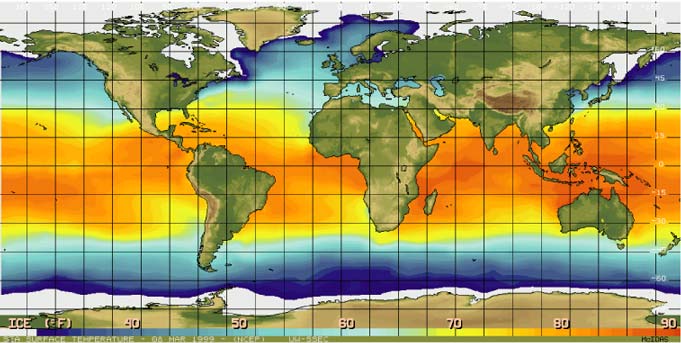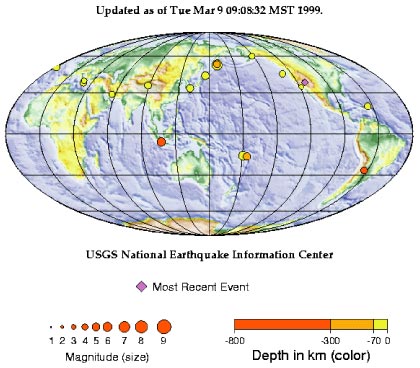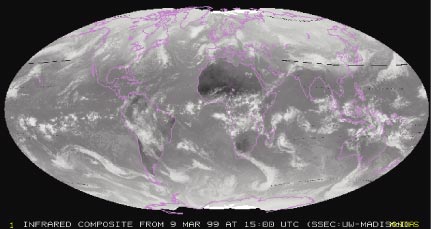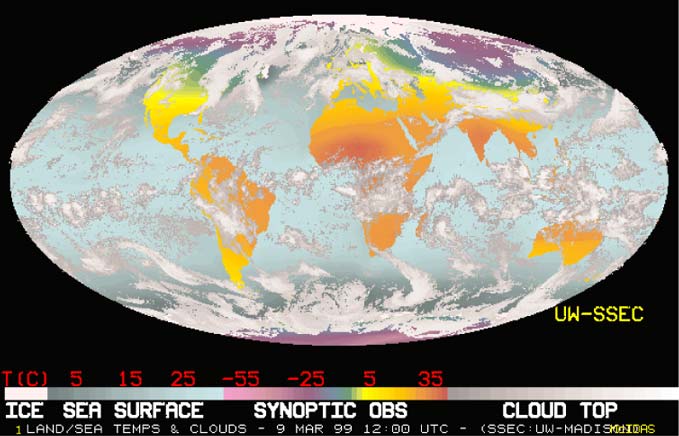
This Article From Issue
May-June 1999
Volume 87, Number 3
DOI: 10.1511/1999.24.0
Earthlings have been observing the changing faces of nearby planets ever since Galileo first pointed his telescope toward the sky. For centuries, the colorful disks of Jupiter, Saturn and Mars were the only planets that offered much of a show. Most other worlds in our solar system were simply too far away to present an interesting view. And the planet that could provide the most entertaining view of all—the earth—was simply too close. It took a while for us to develop the technology to observe our planet, but as anyone familiar with television or the Internet can tell you, we now do so with a vengeance.

Image courtesy of Space Science and Engineering Center, University of Wisconsin at Madison.
Just click onto the World Wide Web and you can see an image of our home world that is usually no more than a few hours old. There's always a full plate of planetary phenomena to see: Watch the eerie flow of the earth's water vapor (which makes the globe look somewhat like the surface of an alien's cerebral cortex), follow the changing temperatures of the world's lands and seas (more complex than you might suspect) and the wispy, almost dreamlike covering of the planet's clouds (better than the Weather Channel), and get up to date on the location of the 21 most recent earthquakes (which are more frequent than you might think).
These global views are remarkable in themselves, but they're also not quite legitimate planet watching: All of them are composites or maps derived from satellite images or from ground-based stations. It's not like looking at the earth through a telescope. This will change in the year 2001, however, when Web surfers will be treated to a global view of our planet as imaged by a spacecraft situated a million miles away. The spacecraft, called Triana, will be located at the Lagrange L1 libration point (where the gravitational tugs of the sun and the earth are effectively neutralized). At that distance, the earth will cover no more than half a degree in Triana's sky—about the size of the full moon—and the onboard camera will have to peer at the earth through a telescope.

Courtesy of USGS, National Earthquake Information Center.
The notion of observing the earth from the L1 vantage point has been a vision of space scientists for decades, but as most scientists know, having an idea is nearly worthless if you don't have the money to make it a reality. This is where the nighttime dreams of Vice-President Al Gore came into play early in 1998. As the story goes, Gore woke up one morning thinking it might be nice to have a high-definition-TV-quality image of the sunlit disk of the earth available on the Internet 24 hours a day, a concept he called "Digital Earth." By the autumn of 1998, less than a year after Gore's vision, the Triana project was born. (There is a lesson here for young people considering a career in science.)

Image courtesy of Space Science and Engineering Center, University of Wisconsin at Madison.
Although Gore's concept was originally criticized by some scientists as having little scientific value, the incarnation of the Triana mission will address some fundamental questions about the earth's climate. The principal investigator of the Triana project, Francisco Valero at the Scripps Institution of Oceanography in La Jolla, California, is adamant that project won't produce "just another screen saver."

Image courtesy of Space Science and Engineering Center, University of Wisconsin at Madison.
Valero's plan for Triana includes a broadband radiometer that will measure the amount of the sun's energy that the earth reflects back to space. Since sunlight is the principal engine driving our weather, an accurate measure of how much solar energy the earth absorbs is critical for climate models. Current means of measuring the reflected energy require the integration of several satellite scans that cover a relatively narrow strip of the earth. "There is a disparity of eight percent between the theoretical and the experimental measures of this value," says Valero. "Part of the problem may be that several satellite scans have to be stitched together to produce a global measure of reflected energy. Triana will be much more accurate because we can average many global snapshots of the earth." In Valero's mind there's little question that good science will come from Triana, and he is already hatching schemes to place earth-observing telescopes at other Lagrange points.

Image courtesy of Space Science and Engineering Center, University of Wisconsin at Madison.
Triana is scheduled to be launched from the Space Shuttle late in 2000, on the eve of the new millennium and nearly 400 years after Galileo. There's something poetic about observing our planet through a telescope: We'll have finally brought the Galilean revolution full circle.—Michael Szpir
American Scientist Comments and Discussion
To discuss our articles or comment on them, please share them and tag American Scientist on social media platforms. Here are links to our profiles on Twitter, Facebook, and LinkedIn.
If we re-share your post, we will moderate comments/discussion following our comments policy.